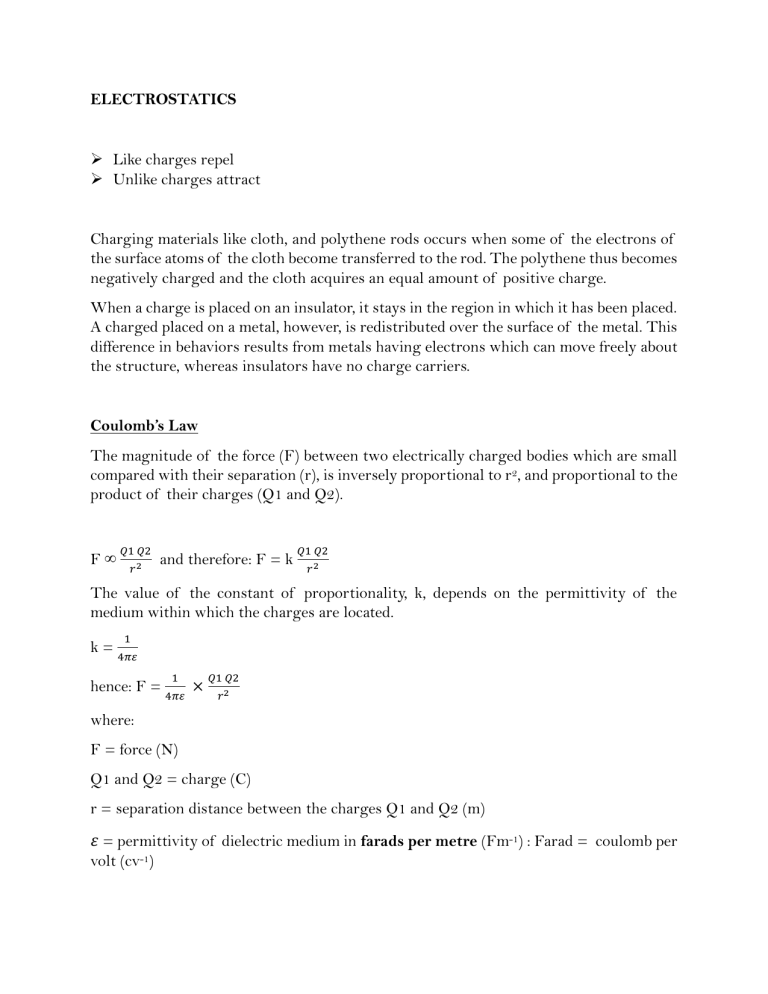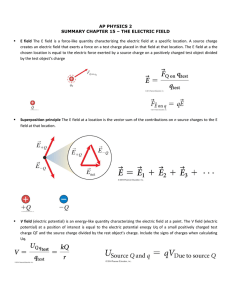
ELECTROSTATICS Like charges repel Unlike charges attract Charging materials like cloth, and polythene rods occurs when some of the electrons of the surface atoms of the cloth become transferred to the rod. The polythene thus becomes negatively charged and the cloth acquires an equal amount of positive charge. When a charge is placed on an insulator, it stays in the region in which it has been placed. A charged placed on a metal, however, is redistributed over the surface of the metal. This difference in behaviors results from metals having electrons which can move freely about the structure, whereas insulators have no charge carriers. Coulomb’s Law The magnitude of the force (F) between two electrically charged bodies which are small compared with their separation (r), is inversely proportional to r2, and proportional to the product of their charges (Q1 and Q2). F∞ 𝑄1 𝑄2 𝑟2 and therefore: F = k 𝑄1 𝑄2 𝑟2 The value of the constant of proportionality, k, depends on the permittivity of the medium within which the charges are located. k= 1 4𝜋𝜀 hence: F = 1 4𝜋𝜀 × 𝑄1 𝑄2 𝑟2 where: F = force (N) Q1 and Q2 = charge (C) r = separation distance between the charges Q1 and Q2 (m) 𝜀 = permittivity of dielectric medium in farads per metre (Fm-1) : Farad = coulomb per volt (cv-1) Electric Fields An electric field exists in a region if electrical forces are exerted on charged bodies in that region. The direction of an electric field at aa point is the direction in which a small positive charge would move under the influence of the field if placed at that point. The electric field intensity or electric field strength (E) at a point is defined as the force exerted by the field on a unit charge placed at that point: units: Vm -1 or NC-1 From the definition of electric field intensity, the force exerted on a charge Q, at a point where the field intensity is E, is given by: F = EQ Hence: E = 𝐹 𝑄 Field Intensity Due to a Point Charge The force on the test charge Q1 due to the point charge Q, in a medium of permittivity, is given by the equation: F= 1 4𝜋𝜀 × 𝑄1 𝑄 𝑟2 Electric field intensity is force per unit charge and therefore, the field intensity E at the site of Q1 is given by: E= 𝐹 𝑄1 Therefore: E= 1 4𝜋𝜀 × 𝑄 𝑟2 Electrical Potential Electrical Potential is the work done in moving a charge from one point in a field to another. *gravitational potential* If two points have different electric potentials, then the potential energy of a charge changes as a result of moving from one point to the other. The potential is a property of the field, the potential energy depends on both the field and the size of the charge. The potential at a point in an electrical field is defined as being numerically equal to the work done in bringing a unit positive charge from infinity to the point. The unit of potential is the volt. The potential of a point at infinity is zero. *for practical purposes, the zero of potential is taken to be the potential of the earth as this is constant (we are usually concerned with the differences in potential. The potential energy of a charge Q at a point where the potential is V, is given by: PE = QV Potential Due to a Point Charge The point charge at A exerts a repulsive force F on the charge at B where: F= 1 × 4𝜋𝜀 𝑄1 𝑄 𝑥2 If the charge at B is moved by some external agent a small distance (𝛿𝑥) towards A where 𝛿𝑥 is so small that F can be considered constant, the work done (𝛿𝑊) by the external agent is given by: F changes as distance changes. 𝛿𝑊 = -F 𝛿𝑥 the (minus sign because the motion is in opposite direction to F). Substituting for F gives: 𝛿𝑊 = - 1 4𝜋𝜀 × 𝑄1 𝑄 𝑥2 × 𝛿𝑥 The total work done in bringing the charge at B from infinity (where x = ∞) to some point a distance from A (where x = r), is therefore given by: 𝑄 If Q1 is a unit charge, the work done is , and therefore by 4𝜋𝜀𝑟 the definition of potential, the potential V at a distance r from a point charge Q in a medium of permittivity 𝜀 is given by: V= 𝑄 4𝜋𝜀𝑟 Potential is the work required to move electrical charge in a conductor in a particular direction. o Potential is a scalar quantity, hence the potential at a point due to a number of point charges is the algebraic sum of the separate potentials due to each charge. o The potential due to a positive charge is positive and the potential due to a negative charge is negative. o All points which are equidistant from a point charge are at the same potential. A surface over which potential is constant is called an equipotential surface. If a point lies on an equipotential surface, the electric field at that point is perpendicular to the surface. The potential energy of a charge Q1 at a distance r from a point charge Q is given by: PE = 1 4𝜋𝜀 × 𝑄1 𝑄 𝑟 Electrical Potential Difference The potential difference between two points in an electrical field is numerically equal to the work done in moving a unit positive charge from the point at the lower potential to that at the higher potential. If the work done in causing one coulomb of electric charge to flow between two points is one joule, the PD between the points is one volt, i.e. 1V = 1 JC-1 The work done in moving a charge through a potential difference is given by: W = QV where: W – the work done (J) Q – the charge (C) V – the potential difference (V) The electric potential energy of a positively charged particle increases when it moves to a point of lower potential. The electrical potential energy of a negatively charged particle increases when it moves to a point of lower potential. The increase in energy results from: - Work being done by some external agent, in which case the increase in potential energy is equal to the work done. OR - A decrease in the kinetic energy of the particle, in which case the increase in potential energy is equal to the decrease in kinetic energy.



